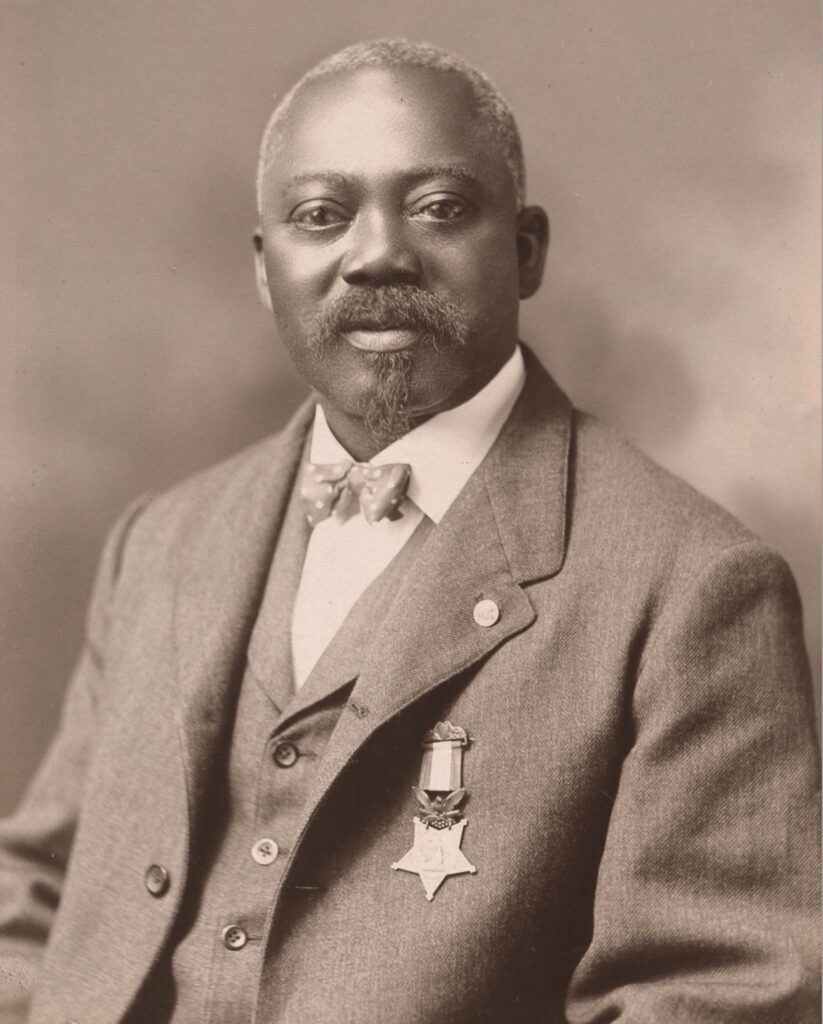Today, we may remember the 54th Massachusetts Infantry, also Sgt. William Harvey Carney, at the Civil War Battle of Fort Wagner from the 1989 film “Glory.” The critically-acclaimed film was released more than 30 years ago, but it stands the test of time for many reasons.

The most important reason is that it’s reasonably true to the history of the unit, with a few of Hollywood’s usual dramatic licenses. The 54th Massachusetts was the first all-Black regiment raised in the Union to fight in the war. Though the movie was based on Robert Gould Shaw‘s letters to his family, all the Black characters are entirely fictional.
What they accomplished was not fictional, however, and neither was their tenacity and courage under fire. It was at the attack on Fort Wagner that one soldier, Sgt. William Harvey Carney became the first Black soldier to receive the Medal of Honor. He did it with his stalwart defense of the American flag.
Carney was born a slave in the area around Norfolk, Virginia, in 1840. When his family was emancipated, they moved north to Massachusetts. It was there that Carney secretly learned to read and write. When the Civil War broke out, he volunteered to fight and free those still in chains in the south.
The 54th Massachusetts was the second all-Black infantry unit formed by the Union Army during the war. It began recruiting troops outside of Boston in February 1863 under the command of Col. Robert Gould Shaw. Carney joined the unit within weeks of its formation, along with 40 other Black men who were dedicated to the cause of ending slavery by force.

Within a few months, they would get their chance. Just south of Charleston Harbor sat Fort Wagner, a heavily defended and well-armed base that had already repulsed one Union assault. Despite numerous feints and an artillery bombardment, the base still held on strong.
Sgt. William Harvey Carney is Standout of The 54th Massachusetts
When the time came for another Union attack on July 18th, it was the 54th Massachusetts who led the way. It was a hazardous undertaking, bottlenecked by the sea, allowing only a 60-yard strip of land to approach the fort. Once there, they faced a 250-yard wall, surrounded by a moat and sharpened Palmetto logs.
After an eight-hour bombardment from the sea, the 54th led the advance on the base at nightfall. They made it about 150 yards from Fort Wagner‘s defenses when the Confederates lit up the night sky with gunfire and artillery. The U.S. Colored Troops even scaled the walls and managed to take the parapet of the fort but were repulsed after hand-to-hand fighting and close-range cannon fire.
Col. Shaw was killed trying to assault the parapet, and 270 soldiers from the 54th were killed, captured, or wounded. The Black prisoners of the Confederates were likely not well-treated by their captors if they weren’t killed outright.
There were a number of standouts from the fighting. Early on, the 54th’s color guard was killed in the unit’s approach to the fort. It was an enlisted soldier, William Harvey Carney, who scooped up the American flag as the flag bearer succumbed to his wounds and carried the flag forward. Though wounded by several gunshots himself, he even carried the flag to the fort’s walls during the doomed attack on the parapet.

Despite quickly losing blood and being near death, he planted the flag in the sand and positioned his body to keep it upright.
The importance of unit colors in combat during the Civil War cannot be understated. It was more than a symbol; men were trained to follow the flag into a blaze of gunfire and to rally around it. The presence of the unit colors kept the unit together in the melee of men and smoke. If the flag had gone down, the men might have thought the battle was lost, causing them to break formation and retreat.
When William Harvey Carney kept the flag high, it kept the unit together, enabling them to press the assault as two other Union units attacked from the other sides of the fort. He not only saved the lives of men from the 54th Massachusetts, he kept Confederates from moving men to repel assaults from the 6th Connecticut, 48th New York, 3rd New Hampshire, 76th Pennsylvania, and the 9th Maine regiments who were also in the fighting.
When he returned to camp, he reportedly said, “Boys, the old flag never touched the ground!” 60 days of constant bombardment later, the Confederates abandoned Fort Wagner.
For keeping Old Glory high in the air that night, Carney was promoted to Sergeant. The 54th Massachusetts‘ performance at Fort Wagner led the Union Army to expand recruitment for the U.S. Colored Troops, a strategy President Abraham Lincoln credited for securing the final Union victory in the Civil War.
In 1863, the Medal of Honor was just a year old. Many of these medals were awarded years after the deeds to receive them were performed on May 23, 1900, Sgt. William Harvey Carney received the Medal of Honor for his dedication at Fort Wagner and wore it the rest of his life.

I wonder if they mention this in CRT? As much as anywhere in our American Society, the military is colorblind. There will always by petty hatreds in the family of man. I guess race is as good as any reason to be petty. Thank you for telling this story.
I felt great pride In Mr. Carney while reading this article. I have read other articles about Black military men performing great deeds in action. I wish more white and black people could read about people like Mr. Carney. His picture shows the pride he had wearing the MOH. I would have been honored shaking his hand. I sincerely thank you for printing Carney story.
This man, William Harvey Carney is truly a national treasure. Thank You for posting.